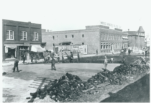Praxis: Prairie sunsets
By Patty Rooks on August 24, 2019.
praxis@praxismh.ca@PraxisMedHat It hit me this evening while I was outside working that summer is slowly coming to an end. My first clue was when the sun started to go down, in what I thought was a bit early. Slowly the fall season is creeping up on us! I appreciate this time of year though as the landscape begins to turn such beautiful colours. The other day, I managed to take in a rather fantastic sunset which of course made me think about how these are formed in the majestic sky above! Let’s investigate further! *Remember to ask an adult before doing this experiment. Materials – one tall clear drinking glass – tap water – one sheet of white paper – good bright flashlight – skim milk – measuring spoon – tape – sturdy work surface near a wall – spoon – dark room Procedure 1. You are going to have to do this experiment in a room that you can darken that also has a good sturdy 2. Place the clear drinking glass on the table. 3. Directly across from the glass, on the wall, tape one sheet of white paper. 4. Fill the glass approximately 3/4 full of water. 5. Shut out the lights. 6. Turn on the flashlight and shine it through the glass of water. 7. Observe the colours that shine through onto the sheet of white paper. 8. Turn the lights back on. 9. Measure out 15 mL (one tablespoon) of milk. 10. Stir the milk into the water. 11. Shut the lights out. 12. Shine the flashlight through the glass of water and milk. 13. Observe what colours shine through onto the white paper now. Explanation What you simulated in this experiment is a beautiful prairie sunset! This experiment replicates the scattering of small particles in the earth’s atmosphere in a glass of water, using a little bit of milk to scatter. After the addition of the milk to the glass, you should have been able to see only the colours orange and red shine through onto the white paper. The sky (especially this time of the year with harvest) is full of dust, and even smoke, pollen and many other particles. These particles filter the sunlight that we can see. As a result, when you look at a sunset, the colours are so vibrant with orange and reds in it. If you are an educator and already planning your lessons for the upcoming school year, do not forget to book your hands on science resources with Praxis ASAP! Patty Rooks, Senior Scientific Consultant PRAXIS, “Connecting Science To The Community”. Contact Praxis at praxis@praxismh.ca, http://www.praxismh.ca, Tweet or follow us @PraxisMedHat, or friend us on Facebook. NOTE our NEW address: #12 826 11 Street S. E., Medicine Hat, Alberta, T1A 1T7 Phone: 403-527-5365, email: praxis@praxismh.ca. 34-33




